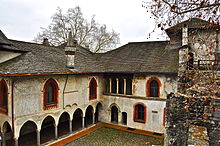Museo civico e archeologico
The Museo civico e archeologico (“Municipal and archaeological museum”) is a museum of the city of Locarno in the Swiss canton of Ticino , which is housed in the Castello Visconteo on the western edge of the old town. The archaeological collection in the castle and the Castello itself are both protected cultural asset of national importance. The neighboring Palazzo Casorella is available for special exhibitions .
History of the structure
The castle dates back to the 12th century and was greatly expanded under the rule of the Visconti (1342–1439) and the Rusca (1439–1512). In the 16th century, about two-thirds of it was razed by the Confederates and served as the seat of the federal bailiffs from 1513 to 1798 . The building of the museum consists of two late medieval buildings from the Rusca period, which were restored in a historicizing manner between 1921 and 1928 under the direction of the painter Edoardo Berta . In the pedestrian underpass on the south side, some remains of the old port and the castle are visible, which date back to the 13th to 15th centuries.
After the restoration, the city museum was set up in the castle, which was later expanded to include the archaeological collection, a permanent exhibition on the peace conference held in Locarno in 1925 and, finally, one on the Reformation in 2017.
Collections
The archaeological museum is known for its significant collection of Roman glass . The finds go back to excavations that were made on grave fields in the region towards the end of the 19th century. It is supplemented by other exhibits from Roman times from the 1st to 4th centuries; other finds come from the Bronze Age and are over 3000 years old.
The upper rooms are dedicated to the 1925 Peace Conference and the Locarno Treaties . The exhibition is accompanied by a historical tour that leads to the conference venues. Clothing and Nymphenburg porcelain are also on display .
On September 16, 2017, the new section of the permanent exhibition Locarno città della Riforma. Dall'esilio dei protestanti alla costruzione della tolleranza opened (“Locarno, City of the Reformation. From Protestant Exile to Building Tolerance”). He pays tribute to the city's importance for the Reformation and its appointment as the “ Reformation City of Europe ”.
The museum in the castle is closed from November to March and not barrier-free. It is to be expanded or rebuilt. Another part of the municipal collections, the picture gallery, is located in the Casa Rusca, an 18th century palazzo with an inner courtyard and loggia .
literature
- Yvonne Bölt, Maurizio Checchi: Locarno, guida storico-artistica e dintorni. Serodine, Ascona; A. Dadò, Locarno 1996, ISBN 88-86315-55-4 .
- Elfi Rüsch, Riccardo Carazzetti: Locarno. The castle and the Casorella (= Swiss Art Guide. Series 72, No. 711). Edited by the Society for Swiss Art History GKS. Bern 2002, ISBN 3-85782-711-4 .
Web links
- locarno.ch: Museo civico e archeologico. Official website of the museum (Italian)
- Archaeological and City Museum
- Castello Visconteo, Locarno - Museo civico e archeologico (Italian)
Individual evidence
- ^ Category "A" in the inventory of cultural property protection with objects of national importance, KGS-DS-No. 11788. In: geo.admin.ch. Federal Office for Civil Protection, accessed on December 9, 2017.
- ↑ Cultural property of category "A", KGS-DS-No. 5507.
- ↑ Cultural property of category "A", KGS-DS-No. 9266.
- ^ Museo civico e archeologico. In: locarno.ch, accessed on December 9, 2017 (Italian).
- ↑ Cultural property of category "A", KGS-DS-No. 8637.
- ^ Cultural property of category "B", KGS-DS-No. 5512.
Coordinates: 46 ° 10 '4.6 " N , 8 ° 47' 36" E ; CH1903: 704625 / 113843



